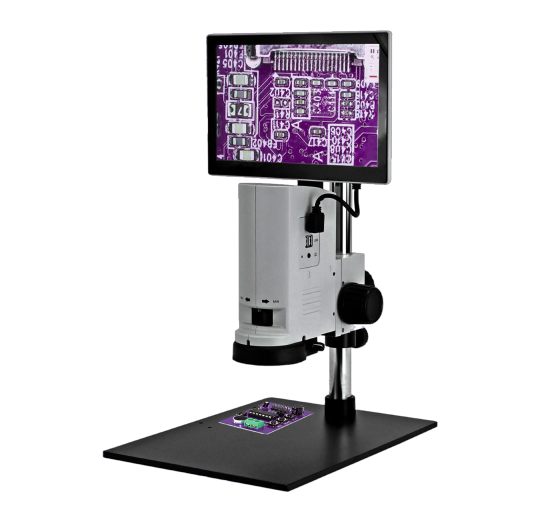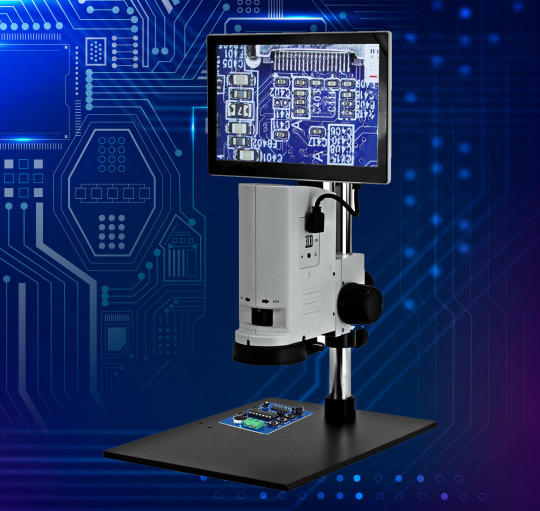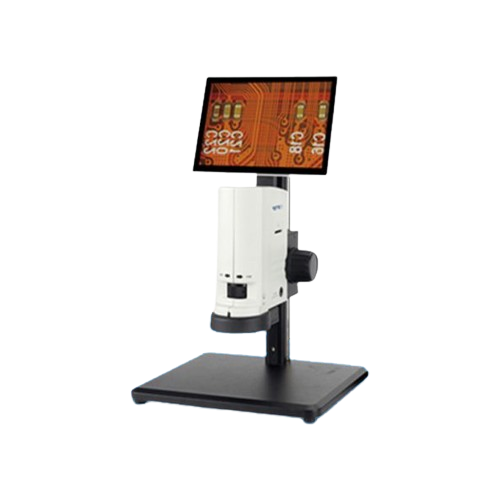Don't wanna be here? Send us removal request.
Text
PCB Microscope

The PCB Microscope designed with precision and engineered for perfection, this cutting-edge microscope is every electronics enthusiast's dream tool. With crystal-clear optics and adjustable LED lighting, every trace, component, and solder joint will be revealed in stunning detail. Don't let any defects or hidden issues go unnoticed - trust the PCB Microscope to revolutionize your inspection process and ensure flawless PCB assembly.
A PCB inspection stereo microscope is a type of microscope specifically designed for inspecting printed circuit boards. It is used to magnify the components and traces on a PCB, allowing for detailed inspection and analysis. PCBs are integral components of electronic devices and contain difficult circuits and components that need to be inspected for quality assurance, troubleshooting, and repair purposes.
A PCB microscope typically offers high magnification capabilities to allow for detailed inspection of the PCB's components, traces, and solder joints. It often features adjustable lighting options to provide optimal illumination for clear visibility during inspection. Some models may also have software capabilities for image analysis, measurement, and annotation to aid in documentation and analysis.
0 notes
Text
TP 50 Dispensing Controller is a device used for controlling the dispensing of fluids or materials in various industrial applications. It offers accurate control over the dispensing process, allowing for accurate and consistent dispensing of materials.
0 notes
Text
A binocular metallurgical microscope is a specialized microscope used for examining opaque objects at high magnification. It is commonly used in metallurgy, material science, and other fields where the microstructure of metals and materials needs to be analyzed. The binocular design allows for comfortable viewing through both eyes, and the microscope often includes features such as polarizing filters, bright field and dark field illumination, and the ability to observe specimens in reflected light. This type of microscope is essential for studying the structure and properties of metals and materials at the microscopic level.
0 notes
Text

PCB Microscopes are essential tool in electronic manufacturing, repair and debugging process engaged in difficult tasks such as circuit board inspection and soldering. It provides magnification and illumination to help users inspect and work on small components and solder joints on PCB with accuracy and with higher illumination options they facilitate a well-lit workspace for precise work.
If you are in the business of electronic manufacturing or suppliers, JB Instruments provide you a wide range of PCB Inspection Microscope specially designed for PCB that help you accomplish effective and accurate. These microscopes are essential for efficient and precise PCB Inspection whether it be for quality control, rework failure analysis or research and development purposes.
The Performance of PCBs regardless of whether they are single-sided, double-sided or multilayer is heavily reliant on the quality of soldering through hole and components such as diodes, IC, Chips and capacitors. It is crucial to thoroughly check these components to ensure they meet the necessary standards.
PCB inspection with JBM microscopes can be performed fast and easily. View a large overview of the sample and simply zoom in on a region of interest with high concert zoom optics, view high quality images, long working distance, 3D image viewing, solder joints and more.
There are two types of microscope for PCB Inspection
Digital Microscopes
Stereo Microscopes
The main difference lies in the way the viewer can view their work. Either using eyepiece or viewing the image on a screen.
Digital Microscopes project the image on the screen which can be more ergonomic allowing for less operator fatigue. Whereas Stereo microscopes are designed to view through eyepiece and provide a 3D view.
0 notes
Text
Digital Microscope for PCB Inspection

PCB Microscopes are essential tool in electronic manufacturing, repair and debugging process engaged in difficult tasks such as circuit board inspection and soldering. It provides magnification and illumination to help users inspect and work on small components and solder joints on PCB with accuracy and with higher illumination options they facilitate a well-lit workspace for precise work.
0 notes
Text
A digital microscope is a useful tool for the electronic industry as it allows for high-resolution imaging and analysis of electronic components and circuit boards. It can be used for various applications such as inspection, quality control, and failure analysis.
Some key features to consider when choosing a digital microscope for the electronic industry include:
Magnification: Look for a microscope with adjustable magnification levels to suit different inspection needs. Higher magnification allows for detailed examination of small electronic components.
Resolution: A higher resolution microscope will provide clearer and more detailed images, enabling better analysis of electronic components.
Lighting: Adequate lighting is crucial for proper inspection. Look for a microscope with built-in LED lighting or the ability to connect external lighting sources.
Connectivity: Consider whether the microscope has the capability to connect to a computer or other devices for image capture, storage, and analysis. This can be important for documentation and sharing of inspection results.
Software: Check if the microscope comes with user-friendly software that allows for image capture, measurement, and analysis. Some microscopes may also offer additional features like image stitching and 3D reconstruction.
Ergonomics: Consider the design and ergonomics of the microscope, especially if it will be used for long periods. Look for features like adjustable height, comfortable viewing angles, and easy-to-use controls.
Durability: In the electronic industry, the microscope may be exposed to various environmental conditions. Choose a microscope that is durable and can withstand the demands of the industry.
When selecting a digital microscope for the electronic industry, it is important to consider the specific requirements and applications of your work. It is also recommended to read reviews and compare different models to find the one that best suits your needs.
0 notes
Text
Digital Microscope is a type of microscope that uses optics and a digital camera to output an image to a screen often through software running on a computer. Digital Microscope differs from traditional microscopes by their ability to capture images and videos, often at high resolutions, for documentation or analysis purposes. They are becoming increasingly popular in various fields, including biology, metallurgy and electronics.
0 notes
Text
Digital Microscope is a type of microscope that uses optics and a digital camera to output an image to a screen often through software running on a computer. Digital Microscope differs from traditional microscopes by their ability to capture images and videos, often at high resolutions, for documentation or analysis purposes. They are becoming increasingly popular in various fields, including biology, metallurgy and electronics.

0 notes
Text
Monozoom Microscope
Jb Microscope provides a wide range of Monozoom microscopes suited for various applications. Browse our collection and enhance your scientific exploration today

0 notes
Text
Jb Microscope provides a wide range of monozoom microscopes suited for various applications. Browse our collection and enhance your scientific exploration today
0 notes
Text
Microscope for Medical Industry
Microscopes are essential tools in the medical industry, revolutionizing diagnostics, research, and treatment. These instruments magnify minuscule biological structures, allowing healthcare professionals to research into the particulars of cells, tissues, and microorganisms. In pathology, microscopes aid in accurate disease diagnosis by examining tissue samples at a microscopic level. They play a important role in hematology, enabling the analysis of blood cells for conditions such as anemia or leukemia.
Microscopes also contribute significantly to microbiology, facilitating the identification and study of bacteria, viruses, and other pathogens. In research, they empower scientists to explore the molecular basis of diseases, fostering the development of targeted therapies. Fluorescence microscopy, for instance, helps visualize specific molecules within living cells, advancing our understanding of cellular processes.
The medical industry continually benefits from technological advancements in microscopy. Confocal and electron microscopes offer enhanced resolution, providing detailed 3D images and enabling discoveries at the Nano scale. Digital microscopy integrates with computer systems, facilitating documentation and sharing of findings for collaborative research and remote consultations.
Moreover, in surgical settings, microscopes assist surgeons in performing intricate procedures with precision, improving outcomes in fields such as neurosurgery and ophthalmology. The integration of microscopy with other technologies like artificial intelligence further augments diagnostic capabilities, accelerating the pace of medical discoveries.
0 notes
Text
Stereo zoom microscope is a type of optical microscope designed for low magnification observation of a sample. It provides a three-dimensional view of the specimen by using separate objective lenses and eyepieces to create two different optical paths for each eye. The stereo zoom microscope is particularly useful when a three-dimensional representation of the sample is necessary.
0 notes
Text

The PCB Microscope designed with precision and engineered for perfection, this cutting-edge microscope is every electronics enthusiast's dream tool. Get up close and personal with your printed circuit boards like never before, thanks to its powerful magnification capabilities. With crystal-clear optics and adjustable LED lighting, every trace, component, and solder joint will be revealed in stunning detail. Don't let any defects or hidden issues go unnoticed - trust the PCB Microscope to revolutionize your inspection process and ensure flawless PCB assembly.
0 notes
Text
PCB Microscope
In the intricate area of electronics, where precision is paramount, a vital tool emerges to reveal the minute details hidden to the naked eye - the PCB microscope. PCB, or Printed Circuit Board, microscopes are specialized optical instruments designed to inspect and analyze electronic components at a microscopic level. These microscopes play a crucial role in various industries, including electronics manufacturing, quality control, and research and development.

The PCB microscope is a fundamental tool in the world of electronics, offering a close-up view into the intricate details of printed circuit boards. Its applications span across manufacturing, quality control, research, and forensic analysis, contributing to the reliability and innovation of electronic devices. As technology continues to evolve, so too will the capabilities of PCB microscopes, providing engineers and technicians with the tools they need to push the boundaries of what's possible in the realm of electronics.
0 notes